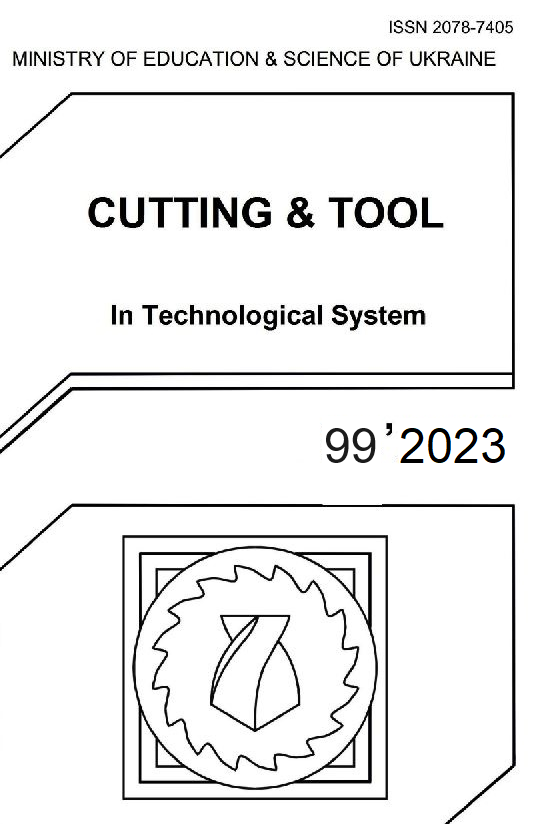ALTERATION OF THE CUTTING FORCE COMPONENTS IN TANGENTIAL TURNING
DOI:
https://doi.org/10.20998/2078-7405.2023.99.02Keywords:
design of experiments, feed force, major cutting force, passive force, tangential turningAbstract
In the development of cutting procedure, the study of the cutting force is important to evaluate the possible loads and elastic deformations in the machining system. The unusual relative position of the cutting tool leads to a changing characteristic of the cutting force in tangential turning. Therefore, it is particularly important to study the values and ratios of the cutting force components in different setups in this finishing procedure. In this paper the depth of cut, feed, and cutting speed are changed, and the effect of these parameters are analysed on the major cutting force, feed force and passive force. The full factorial design of experiment method is applied in the selection of setup parameters and the evaluation of the results. The maximal values and the ratio of the force components were analysed by the determination of equations.
References
Byrne, G., Dornfeld, D., Denkena, B. J. C. A.: Advancing cutting technology. CIRP Annals, 52(2), pp. 483–507. (2003).
Klymenko, G. P., Vasylchenko, Y., & Donchenko, Y.: Quality management of cutting tools on heavy machines. Rezanie I Instrument V Tehnologiceskikh Sistemakh/ Cutting And Tool In Technological Systems, (94), pp. 135–141. (2021).
Balwan, V. R., Dabade, B., Wankhade, L.: Influence of hard turning parameters on cutting forces of EN 353 steel. Materials Today: Proceedings, 63, pp. 149–156. (2022).
Pathapalli, V. R., P, S. R., Basam, V. R., Doni, M. K.: Multi Response Optimization of Turning Process by Considering its Cutting Parameters Implementing Grey Relational Analysis. International Journal of Integrated Engineering, 11(8), pp. 110–118. (2019).
Kundrak, J., Palmai, Z., Varga, G.: Analysis of tool life functions in hard turning. Tehnički vjesnik, 27(1), pp. 166–173. (2020).
Felho, C., Varga, G.: Theoretical roughness modeling of hard turned surfaces considering tool wear. Machines, 10(3), 188. (2022).
Nagy, A., Varga, G.: Effect of abandonment of cooling and lubrication on surface roughness and cylindricity in turning of steel. Multidiszciplináris Tudományok, 11(4), pp. 395–407. (2021).
Kundrák, J., Markopoulos, A. P., Karkalos, N. E., Makkai, T.: The examination of cutting force as function of depth of cut in cases with constant and changing chip cross section. In Advances in Manufacturing II: Volume 4-Mechanical Engineering (pp. 405–415). Springer International Publishing. (2019).
Felhő, C., Rakonczai, E.: FEM investigation of cutting force components in high-feed face milling. Rezanie I Instrument V Tehnologiceskikh Sistemakh/ Cutting And Tool In Technological Systems, (91), pp. 191–199. (2019).
Manovytskyi, O., Klymenko, S., & Burykin, V.: Calculation of shear angle when cutting with a tool of a negative rake angle. Rezanie I Instrument V Tehnologiceskikh Sistemakh/ Cutting And Tool In Technological Systems, (97), pp. 59–69. (2022).
Schreiber, L., Trott, K.: Verfahren zur drallfreien spanenden Bearbeitung von rotationssymmetrischen Flächen. Patent DE19963897A1. (1999).
Kunstfeld, T., & Haas, W.: Shaft surface manufacturing methods for rotary shaft lip seals. Sealing technology, 2005(7), pp. 5–9. (2005).
Nee, A. Y. C., & Venkatesh, V. C.: Form accuracy of tangentially skived workpieces. CIRP Annals, 34(1), pp. 121–124. (1985).
Downloads
Published
Issue
Section
License
Copyright Notice
Authors who publish with this Collection agree to the following terms:
1. Authors retain copyright and grant the Collection right of first publication with the work simultaneously licensed under a Creative Commons Attribution License that allows others to share the work with an acknowledgement of the work's authorship and initial publication in this Collection.
2. Authors are able to enter into separate, additional contractual arrangements for the non-exclusive distribution of the Collection's published version of the work (e.g., post it to an institutional repository or publish it in a book), with an acknowledgement of its initial publication in this Collection.
3. Authors are permitted and encouraged to post their work online (e.g., in institutional repositories or on their website) prior to and during the submission process, as it can lead to productive exchanges, as well as earlier and greater citation of published work.

